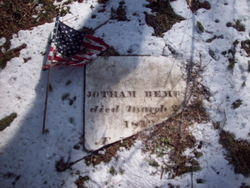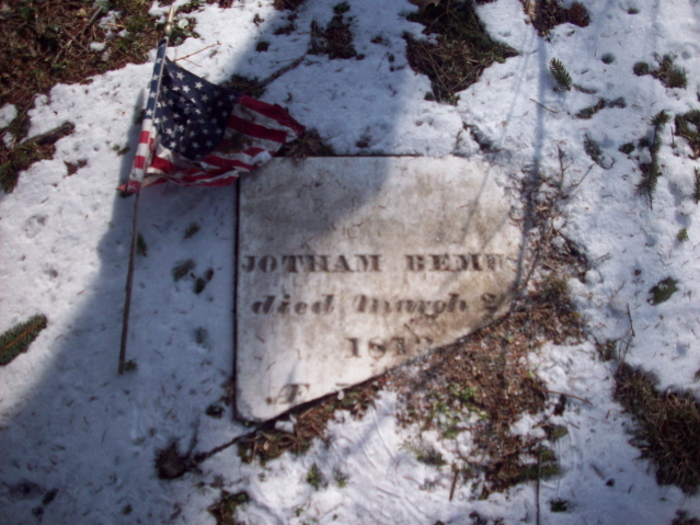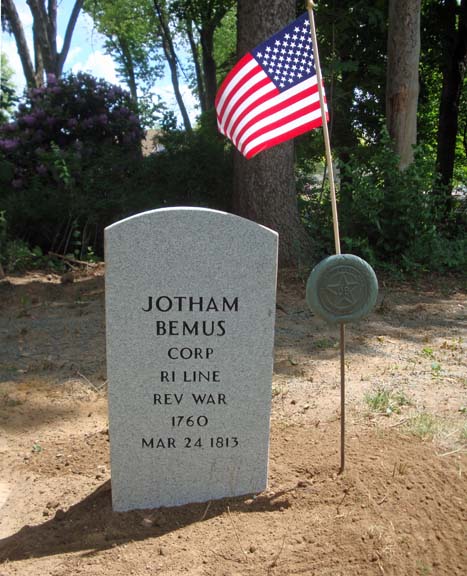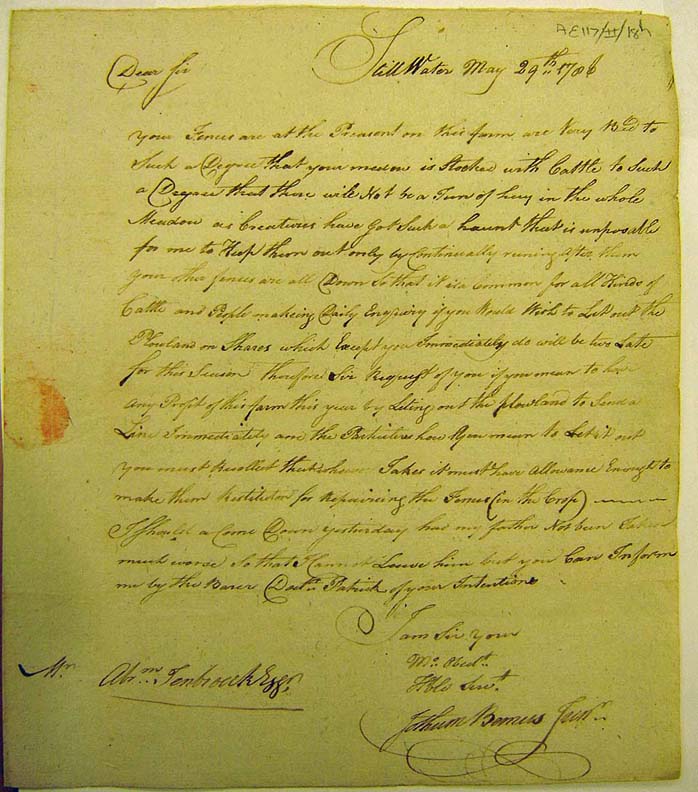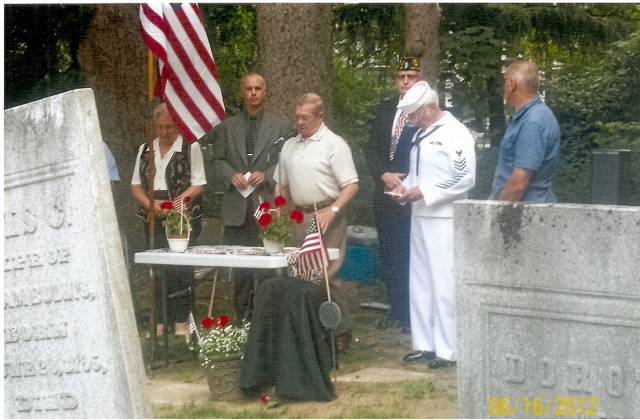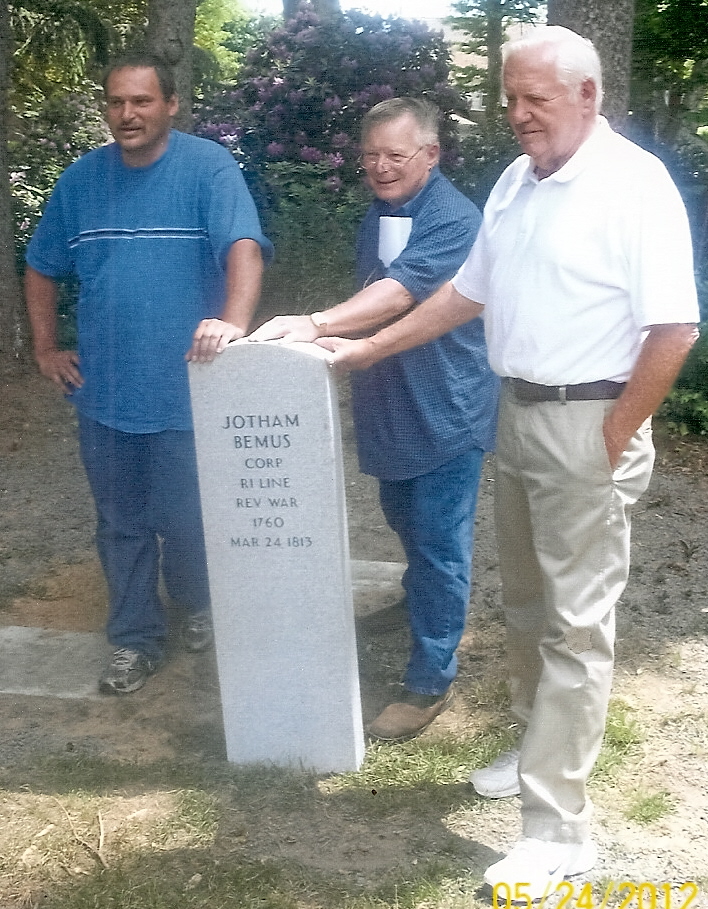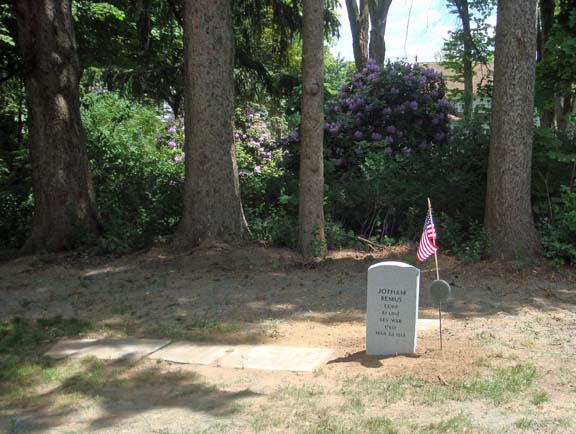He served during the Revolutionary War, was at The Battle of Saratoga, and Valley Forge. He was awarded the Badge of Merit by Gen. George Washington.
Son of Jotham & Tryphena Moore Bemus, husband of Aseneth Andress
Brother: William Bemus
Brother: John Bemus
Sister: Sarah Bemus
1/2 Sister: Nancy Bemus
Revolutionary War Hero to be
Memorialized in Orchard Park
by: Suzanne S. Kulp,
Orchard Park Historian, 2012
Old soldiers never die, nor do they really fade away! Consider Jotham Bemus Jr., born in 1760 in colonial Saratoga, New York, and died in the hamlet of Armor, Hamburg, New York in 1813 as a result of a leg injury and/or resultant disease suffered as he participated in the War of 1812. A stalwart patriot, this was his third and final endeavor in establishing and maintaining our Republic. His unselfish contributions to our great country shall be celebrated at 11:00 a.m. on Saturday, June 16, when a new grave monument will be unveiled in the Deuels Corners Cemetery, Orchard Park.
By way of background, Jotham's father, Jotham Bemus Sr., born in Connecticut in 1738, explored the horizons up the Hudson River, and chose to homestead on the west bank of the Hudson about four miles north of the village of Stillwater. There, about 1759, he established a tavern, the only noteworthy public house between Albany and Fort Edward, and married Tryphenia Moore. Daniel Hazeltine Post, in his Jotham Bemus of Bemus's Heights, describes Jotham Sr. as "of stout build and vigorous and determined character. He was a farmer, energetic and enterprising, engaging in buying cattle and in other traffic, in 1774 a justice of the peace, evidently a man in easy circumstances."
They had four children: Jotham Bemus Jr. (our subject); William Bemus (1762-1830), married Mary Prendergast and became pioneer settlers of the Chautauqua Lake area of Chautauqua County (Bemus Point is named for him); John Bemus (1763-1829), married Sally Lee and remained in Saratoga County, probably continuing his father's affairs, although he invested in land in Armor (Hamburg), New York; and Sarah "Sally" Bemus (1768-1865) married Daniel Crawford and went West fo Evansville, Indiana.
After Jotham Sr.'s first wife died, he married a second time prior to January 1781 to a lady known only as Hannah, and had two more children, Nancy (1782 - 1854), and James Bemus, for a total of six children.
In 1776, Jotham Bemus Jr. left home at about age 17, and enlisted for one year as a Private in the Continental Army, in Col. Gozen Van Schaick's New York Regiment, later serving in the Rhode Island Regiment under Lt. Col. Jeremiah Olney and Col. Christopher Greene, followed by Capt. William Tew and Col. Israel Angell. Little did he realize the notoriety awaiting his family's homestead, and that he would ultimately serve six years, one month, and ten days!
From September 19 to October 7, 1777, two battles took place, collectively called the Battle of Saratoga (New York): first, the Battle of Freeman's Farm, and, second, the Battle of Bemus Heights. Jotham Sr. was then about 40 years old.
The Battle of Saratoga was the most significant battle of the Revolutionary War, considered to be one of the most decisive in all history, and was the major turning point in the struggle of our forefathers for liberty. British General John Burgoyne had planned his invasion to advance from Canada to Albany. Loyalist John Freeman of Freeman's Farm (not related to the early Freemans of Orchard Park), where the first battle took place, became a scout for Burgoyne. His family's log home was used as Burgoyne's field headquarters, and later burned, along with his farm buildings, his livestock sold to the British Commissary. The family sought refuge in Quebec, where most of them perished during a smallpox epidemic. It was during this battle that General Benedict Arnold severely damaged his leg for the second time, and a disagreement with General Horatio Gates escalated, likely the beginning of his contrary attitude which culminated in his traitorous action at West Point three years later.
Burgoyne's thrust was repulsed at the Battle of Bemus Heights, defeated by determined patriots. He and his 5,000 to 6,000 British, German, Canadian and Indian troops surrendered to General Horatio Gates. By the time of the surrender, the American force consisted of 12,000 to 14,000 indomitable militia and troops variously in uniform or rough clothing.
Jotham Bemus Sr. and his sons, William, and John, fought the British in the Battles of Saratoga, most certainly in the Battle of Bemus Heights. William Bemus was a member of Captain Ephraim Woodworth's company, 13th Regiment, known as the Saratoga regiment, Colonel van Vechten (or Van Veghten), who was on Gen. Gates's staff, Regimental Commander. He lived at Dove-gat, or Van Vechten's Cove, between Bemus's Heights and Schuylerville. Youngest son John's obituary in the Saratoga Sentinel, September 15, 1829, notes, "Though young he was in the American service at the capture of Burgoyne, as a teamster."
Our subject, Jotham Jr., was definitely in military service at that time under the command of Col. Van Schaick. Reasonable research has not revealed the whereabouts of Col. Van Schaick's troops at this time, but it is thought they were among the many thousands who fought Burgoyne in the Battle of Saratoga.
The demise of the Bemus homestead was recalled by Jotham Sr.'s daughter, Sarah, as told to her grandson, Rev. S. Hawley Adams of Jamestown, New York. Sarah, who was born at Bemus Heights, ".... spent hours in telling me of Burgoyne and his army, which she saw; of the burning of her father's house by the British, and of the sufferings of the family for a time while they were wintering in a barn – Burgoyne having destroyed all their buildings and crops."
After the October 17, 1777, victory at Saratoga, Commanding General George Washington summoned reinforcements to Philadelphia in November 1777. Fresh from the triumph, three brigades of men from the Saratoga battle joined in the military effort in the Philadelphia area. Jotham Jr., by then a member of the Rhode Island regiment, found himself spending a wretched winter at Valley Forge (December 1777 - May 1778) with General Washington et al. His "Company Muster Roll" for April 1778 shows that he was a Private in Capt. Thomas Arnold's Company in the 1st Battalion of Rhode Island Troops, commanded by Colonel Christopher Greene.
On June 18, 1778, the British evacuated Philadelphia, and on the next day the Continental Army left Valley Forge, crossing the Delaware River with General Washington. Pursuing the British, they intended to strike whenever a good opportunity presented. The two armies met in Monmouth, New Jersey, and the terrible Battle of Monmouth followed. General Washington was known to be a very capable leader, but riding into the thick of this battle with remarkable courage and skill, he proved himself to be one of the greatest soldiers of all time.
Jotham Bemus Jr. stayed with the Rhode Island regiment, continuing to participate in their engagements. The pay roll of March 1, 1780, Capt. William Tew's company commanded by Col. Israel Angell, shows Pvt. Jotham Bemus received 6.60 per month for the months of January and February, 1780, plus 20 "subsistance" for a total of "33 30/90 Dollars." Their next major conflict was the Battle of Springfield, New Jersey, on June 23, 1780, which was commanded by General Washington's second-in-charge, Major General Nathanael Greene.
With about 2,050 men, Maj. Gen. Greene prepared several defensive lines in the Springfield area, focusing on the bridges over the Rahway River. Col. Israel Angell's 2nd Rhode Island, under whose direction Jotham Jr. served, were posted to defend a bridge. The British did not advance toward the bridges, however, but elected instead to burn Springfield. With the town ablaze, the British withdrew back towards New York, with the New Jersey militia attacking their flanks all the way back to Elizabethtown. This was the last major battle of the war to be fought in the North, and the last attempt of the British to invade New Jersey.
Presumably, the Rhode Island regiment continued to move to the South, chasing the British and engaging in skirmishes. The last major battle engaged in by the Rhode Island regiment was in Yorktown, Virginia from September 28 to October 19, 1781. By this time, the French had joined the American cause, and 7,800 French troops joined 8,800 American troops against 7,500 British troops. The result was a resounding defeat of the British troops led by Lt. General Lord Charles Cornwallis. The victory at Yorktown was the last major engagement of the American Revolution and effectively ended the conflict in the American's favor.
It was almost two years later that Jotham Bemus Jr. was discharged on June 15, 1783, in his hometown of Saratoga, New York with the rank of Corporal. He was discharged by General Washington, receiving a badge of merit for his years of faithful service, having served for six years, one month, and ten days!
He wed two years later, in September,1785, in Stillwater, Saratoga Co., New York to Aseneth Andrus, and they began their family of four daughters, all born in Saratoga County.
Jotham's second military committment is outlined in The Military Minutes of the Council of Appointment of the State of New York under date of October 2, 1794. In notes for Saratoga County: "His Excellency the Commander-in-Chief having signified to the Council his intention of forming two troops of horse in the brigade of militia in Saratoga county, whereof James Gordon is brigadier general - Resolved therefore, that the following officers be and they are hereby appointed to compose the said two troops, viz: ....Jotham Bemus, Captain..........", and under date of August 20, 1801, "In Lieutenant Colonel Commandant Samuel Clark's regiment: ....... Jotham Bemus Captain, John Bemus lieutenant [Jotham's brother]....."
Jotham Jr., his wife Aseneth, and their four daughters removed to Western New York, sometime just prior to 1803. In March 1803, the first town meeting to be held on the Holland Purchase took place in Batavia, the hub of activity for Joseph Ellicott and the Holland Land Company. Jotham Bemus Jr. was a candidate for the position of Supervisor, but lost to his opponent by only 4 votes out of a total of 144! However, that year, he was a member of the first grand jury west of the Genesee River which sat in the court house just completed at Batavia. It is probable that the family first settled somewhere in the Batavia area, within an easy reach of the court house and assembly places.
On June 4, 1805, Jotham Jr. took "articles" of land in the present hamlet of Armor, Erie County, New York, committing himself to buying, on terms, the entirety of Great Lots 44 (369 acres) and 37 (349 acres). He planned to build on Great Lot 37. On March 1, 1810, he also committed to purchasing a portion of Great Lot 28 (143 acres). Eager to attract pioneer settlers to the wilderness of Western New York, the Holland Land Company gave extended, easy terms, with the deed granted upon total fulfillment of the terms. In subsequent years, records show that Jotham Jr. made periodic payments, but he took deed to only one 62 acre section of Lot 44 on October 20, 1809 for which he paid $133.52, and subsequently sold it on April 9, 1812 for $307. At the first town meeting of Hamburg (then spelled Hamburgh) held on April 7, 1812, Jotham Bemus was named a pound master, responsible for the feeding and care of wayward livestock such as hogs, cattle, horses and sheep placed in the town pound by the citizenry. It was also his responsibility to read the wayward animals cattle marks and determine the rightful owner. Obviously, wildlife was somewhat of a problem, as at that meeting it was voted, "That on wolves and panthers taken within this town, there shall be paid five dollars per head."
Jotham Jr. and Aseneth's eldest daughter, Tryphenia Mary Bemus born 1789, married before 1813 to Samuel Cotton; their second daughter, Lydia Bemus born 1795, married September 13, 1812 to Dr. William Warriner.
Jotham Jr.'s third and last military commitment came at the time of the War of 1812, a conflict which had its origins in continuing negative relations with Britain. The war had three frontiers, one of them the Niagara region.
Residents of the entire Niagara region were unnerved, and militia groups were formed. In addition to the regular militia, "a company of 'Silver Greys,' men too old for military duty, was formed by Captain Jotham Bemus, aged then about 52, in Hamburg. As a further defense against the foe, especially against the Indians, Captain Bemus' barn was surrounded by a stockade consisting of logs about fifteen feet long, hewn so as to fit closely together, and set side by side about three feet in the ground. Loop-holes were made for rifles, and the stockade would have been a good defense against any weapons but artillery. We are informed that there was also a block-house in the town, but cannot give the locality. At the time of the battle of Black Rock and destruction of Buffalo, three residents of the old town of Hamburg were slain, Newman Baker, Parley Moffatt and William Cheesman."1
There is no information to be found as to what Captain Bemus' company did in the War of 1812. It is known that in October 1812, an attack was launched from the Buffalo waterfront with the intention of capturing two brigs anchored at Fort Erie. Captain Cyrenius Chapin, M.D., was involved in the successful venture, but it would appear that army regulars, not volunteer militia, were involved in this exercise. It should be mentioned, however, that on April 16, 1813, Cyrenius Chapin signed a legal document as a witness to the signatures of Aseneth Bemus, her son-in-law Samuel Cotton, and two others, a statement of Obligation binding the administrators having to do with the estate of Jotham Bemus Jr. Cyrenius, who had many hats, held the office of Sheriff of Niagara County (Erie County had not yet been carved from Niagara County) during the War of 1812. Maybe this had something to do with his signature on the document, but it is more likely that Cyrenius had a direct relationship with Jotham Jr.
There is a strong possibility that Captain Bemus' stockade and militia formation had as much, if not more, to do with the Seneca Indian situation. It is well known, and understandable, that Indian resentment for these newfound Caucasian interlopers into Seneca territory, who had herded them into reservations on the Niagara frontier, was causing aggression and raids into the pioneer settlements which had to be dealt with by a militia.
Jotham Jr. died on March 24, 1813 in Armor reportedly of a leg wound and/or disease caused by activity in the War of 1812. This was prior to the April 1813 American attack on York (now Toronto), which continued into the Niagara Region, May 1813 capture of Fort George, Commodore Perry's September 1813 victory over the British on Lake Erie, and the October 1813 burning of Newark (now Niagara-on-the-Lake). Bloody skirmishes continued; the British captured Fort Niagara in December 1813, burned Lewiston, and set their sights on Black Rock and Buffalo which they burned on December 30, 1813.
Jotham Jr.'s wife Aseneth, and son-in-law Samuel Cotton were executors of his estate. He left an estate valued at $6,224.47 including "Farm Buildings and Nurseryes valued at $4000, Span of horses, 1 mare, 1 colt, 2 yoke of oxen, 5 cows, 3 calves, 3 heifers, 4 yearlings, 1 steer, 30 sheep, 9 hogs, 12 pigs, 13 geese, 5 turkeys," wagon, sleigh, saddles and harnesses, and three pages of miscellaneous possessions including grinding stones, scythes, pounds of tallow and "flower," bushels of barley, oats, peas, corn, potatoes, and grass seed, spinning wheel and yarn, household furnishings and cook ware, "teakittles," knives and forks, washtub, etc. Evidently in 1813, the wife of the deceased was considered to own nothing, as all household items seemed to be itemized and credited to the husband's inventory.
Interestingly, after Jotham's Jr.'s death, his brother John is shown as the owner of Great Lot 37, evidently having financially intervened on behalf of his 46 year-old widowed sister-in-law, Aseneth. Erie County records show that John Bemus of Saratoga County, New York, purchased the entirety of Great Lot 37, 349 acres from the Holland Land Company for $829.25 on September 2, 1814, and on the same day sold two parcels of about 60 acres each carved from that Great Lot to the two married daughters of Aseneth, Mary Tryphenia who had married Samuel Cotton, and Lydia who had married Dr. William Warriner, for $700 each.
On May 19, 1824, John sold his sister-in-law, Aseneth, 116 acres of Great Lot 37 for $1500. Aseneth stayed in Armor through 1847, but in 1850 is found living with her oldest daughter and son-in-law, Mary and Samuel Cotton and family, in Richland, Jackson County, Iowa. Aseneth is buried in the Cottonwood Cemetery, Cottonwood, a community named for this family, Jackson County, Iowa, with her daughter and son-in-law.
Jotham Jr. and Aseneth's second daughter married on September 13, 1812 to Dr. William Warriner, who served as a surgeon during the War of 1812. They remained in the Hamburg area, and are buried in the Deuels Corners Cemetery. Their third daughter, Sallie, married Thomas Levi Wasson, and are also buried in the Deuels Corners Cemetery. Their fourth daughter, Anna, married March 24, 1818, the 5th Anniversary of her father's death, to Lemuel Wasson. She died in Hamburg, and is buried in Deuels Corners Cemetery. After her death, Lemuel lived with his son and family in Richland, Jackson County, Iowa, but is buried with Anna in the Deuels Corners Cemetery.
Mr. Thomas Dunne of Schenectady, New York, a member of the Sons of the American Revolution, and a descendant of Jotham Bemus Jr.'s sister, will be delivering a new, Revolutionary War memorial monument for Jotham Jr.'s grave to replace the small, broken ground level marker that is there. Mr. Al Kaefer, cemetery principal, will help in the setting of the monument. The Historical Society is planning an unveiling of the stone on Saturday, June 16, at 11:00 a.m. with color guard, festivities, and presentations including words by John Wilson, Village Mayor, Dennis Mill, Historical Society President, and David Rebmann, Historian of the American Legion. The community looks forward to welcoming any and all who are interested in this rare event in this quiet, historic cemetery.
sources: 1 H. Perry Smith, History of the City of Buffalo and Erie County, 1884, Vol. I, p. 514, Syracuse, NY; Bryan Thompson, Historian's Office, DeKalb, NY (re: definition of pound master); Colonel Thomas Waln-Morgan Draper, The Bemis History and Genealogy, 1900, San Francisco, CA; various Ancestry.com Family Tree sites; Daniel Hazeltine Post, Jotham Bemus of Bemus's Heights, descendants Rev. S. Hawley Adams of Jamestown, New York, Thomas Dunne of Schenectady, NY; Emslie's Deed Atlas of Erie County, 1839; Karen E. Livsey ,Western New York Land Transactions, 1804-1824, Extracted from the Archives of the Holland Land Company, 1991; marriage record source: Early Settlers of New York State by Janet Wethy Foley, 1934, Vol. I, p. 532: Marriage records copied from Buffalo Newspapers; various War of 1812 internet sources; various census; Joseph Lee Boyle, Death Seem'd to Stare: The New Hampshire and Rhode Island Regiments at Valley Forge, 2005, Baltimore; Prof. John T. Horton, History of Northwestern NY: Erie Niagara, Wyoming, Genesee and Orleans Counties, c.1947, NY, Vol. I, Part I, Chapter II, p. 33; Erie Co. NY Surrogate's Court, file #1400 (1813): Jotham Bemus
He served during the Revolutionary War, was at The Battle of Saratoga, and Valley Forge. He was awarded the Badge of Merit by Gen. George Washington.
Son of Jotham & Tryphena Moore Bemus, husband of Aseneth Andress
Brother: William Bemus
Brother: John Bemus
Sister: Sarah Bemus
1/2 Sister: Nancy Bemus
Revolutionary War Hero to be
Memorialized in Orchard Park
by: Suzanne S. Kulp,
Orchard Park Historian, 2012
Old soldiers never die, nor do they really fade away! Consider Jotham Bemus Jr., born in 1760 in colonial Saratoga, New York, and died in the hamlet of Armor, Hamburg, New York in 1813 as a result of a leg injury and/or resultant disease suffered as he participated in the War of 1812. A stalwart patriot, this was his third and final endeavor in establishing and maintaining our Republic. His unselfish contributions to our great country shall be celebrated at 11:00 a.m. on Saturday, June 16, when a new grave monument will be unveiled in the Deuels Corners Cemetery, Orchard Park.
By way of background, Jotham's father, Jotham Bemus Sr., born in Connecticut in 1738, explored the horizons up the Hudson River, and chose to homestead on the west bank of the Hudson about four miles north of the village of Stillwater. There, about 1759, he established a tavern, the only noteworthy public house between Albany and Fort Edward, and married Tryphenia Moore. Daniel Hazeltine Post, in his Jotham Bemus of Bemus's Heights, describes Jotham Sr. as "of stout build and vigorous and determined character. He was a farmer, energetic and enterprising, engaging in buying cattle and in other traffic, in 1774 a justice of the peace, evidently a man in easy circumstances."
They had four children: Jotham Bemus Jr. (our subject); William Bemus (1762-1830), married Mary Prendergast and became pioneer settlers of the Chautauqua Lake area of Chautauqua County (Bemus Point is named for him); John Bemus (1763-1829), married Sally Lee and remained in Saratoga County, probably continuing his father's affairs, although he invested in land in Armor (Hamburg), New York; and Sarah "Sally" Bemus (1768-1865) married Daniel Crawford and went West fo Evansville, Indiana.
After Jotham Sr.'s first wife died, he married a second time prior to January 1781 to a lady known only as Hannah, and had two more children, Nancy (1782 - 1854), and James Bemus, for a total of six children.
In 1776, Jotham Bemus Jr. left home at about age 17, and enlisted for one year as a Private in the Continental Army, in Col. Gozen Van Schaick's New York Regiment, later serving in the Rhode Island Regiment under Lt. Col. Jeremiah Olney and Col. Christopher Greene, followed by Capt. William Tew and Col. Israel Angell. Little did he realize the notoriety awaiting his family's homestead, and that he would ultimately serve six years, one month, and ten days!
From September 19 to October 7, 1777, two battles took place, collectively called the Battle of Saratoga (New York): first, the Battle of Freeman's Farm, and, second, the Battle of Bemus Heights. Jotham Sr. was then about 40 years old.
The Battle of Saratoga was the most significant battle of the Revolutionary War, considered to be one of the most decisive in all history, and was the major turning point in the struggle of our forefathers for liberty. British General John Burgoyne had planned his invasion to advance from Canada to Albany. Loyalist John Freeman of Freeman's Farm (not related to the early Freemans of Orchard Park), where the first battle took place, became a scout for Burgoyne. His family's log home was used as Burgoyne's field headquarters, and later burned, along with his farm buildings, his livestock sold to the British Commissary. The family sought refuge in Quebec, where most of them perished during a smallpox epidemic. It was during this battle that General Benedict Arnold severely damaged his leg for the second time, and a disagreement with General Horatio Gates escalated, likely the beginning of his contrary attitude which culminated in his traitorous action at West Point three years later.
Burgoyne's thrust was repulsed at the Battle of Bemus Heights, defeated by determined patriots. He and his 5,000 to 6,000 British, German, Canadian and Indian troops surrendered to General Horatio Gates. By the time of the surrender, the American force consisted of 12,000 to 14,000 indomitable militia and troops variously in uniform or rough clothing.
Jotham Bemus Sr. and his sons, William, and John, fought the British in the Battles of Saratoga, most certainly in the Battle of Bemus Heights. William Bemus was a member of Captain Ephraim Woodworth's company, 13th Regiment, known as the Saratoga regiment, Colonel van Vechten (or Van Veghten), who was on Gen. Gates's staff, Regimental Commander. He lived at Dove-gat, or Van Vechten's Cove, between Bemus's Heights and Schuylerville. Youngest son John's obituary in the Saratoga Sentinel, September 15, 1829, notes, "Though young he was in the American service at the capture of Burgoyne, as a teamster."
Our subject, Jotham Jr., was definitely in military service at that time under the command of Col. Van Schaick. Reasonable research has not revealed the whereabouts of Col. Van Schaick's troops at this time, but it is thought they were among the many thousands who fought Burgoyne in the Battle of Saratoga.
The demise of the Bemus homestead was recalled by Jotham Sr.'s daughter, Sarah, as told to her grandson, Rev. S. Hawley Adams of Jamestown, New York. Sarah, who was born at Bemus Heights, ".... spent hours in telling me of Burgoyne and his army, which she saw; of the burning of her father's house by the British, and of the sufferings of the family for a time while they were wintering in a barn – Burgoyne having destroyed all their buildings and crops."
After the October 17, 1777, victory at Saratoga, Commanding General George Washington summoned reinforcements to Philadelphia in November 1777. Fresh from the triumph, three brigades of men from the Saratoga battle joined in the military effort in the Philadelphia area. Jotham Jr., by then a member of the Rhode Island regiment, found himself spending a wretched winter at Valley Forge (December 1777 - May 1778) with General Washington et al. His "Company Muster Roll" for April 1778 shows that he was a Private in Capt. Thomas Arnold's Company in the 1st Battalion of Rhode Island Troops, commanded by Colonel Christopher Greene.
On June 18, 1778, the British evacuated Philadelphia, and on the next day the Continental Army left Valley Forge, crossing the Delaware River with General Washington. Pursuing the British, they intended to strike whenever a good opportunity presented. The two armies met in Monmouth, New Jersey, and the terrible Battle of Monmouth followed. General Washington was known to be a very capable leader, but riding into the thick of this battle with remarkable courage and skill, he proved himself to be one of the greatest soldiers of all time.
Jotham Bemus Jr. stayed with the Rhode Island regiment, continuing to participate in their engagements. The pay roll of March 1, 1780, Capt. William Tew's company commanded by Col. Israel Angell, shows Pvt. Jotham Bemus received 6.60 per month for the months of January and February, 1780, plus 20 "subsistance" for a total of "33 30/90 Dollars." Their next major conflict was the Battle of Springfield, New Jersey, on June 23, 1780, which was commanded by General Washington's second-in-charge, Major General Nathanael Greene.
With about 2,050 men, Maj. Gen. Greene prepared several defensive lines in the Springfield area, focusing on the bridges over the Rahway River. Col. Israel Angell's 2nd Rhode Island, under whose direction Jotham Jr. served, were posted to defend a bridge. The British did not advance toward the bridges, however, but elected instead to burn Springfield. With the town ablaze, the British withdrew back towards New York, with the New Jersey militia attacking their flanks all the way back to Elizabethtown. This was the last major battle of the war to be fought in the North, and the last attempt of the British to invade New Jersey.
Presumably, the Rhode Island regiment continued to move to the South, chasing the British and engaging in skirmishes. The last major battle engaged in by the Rhode Island regiment was in Yorktown, Virginia from September 28 to October 19, 1781. By this time, the French had joined the American cause, and 7,800 French troops joined 8,800 American troops against 7,500 British troops. The result was a resounding defeat of the British troops led by Lt. General Lord Charles Cornwallis. The victory at Yorktown was the last major engagement of the American Revolution and effectively ended the conflict in the American's favor.
It was almost two years later that Jotham Bemus Jr. was discharged on June 15, 1783, in his hometown of Saratoga, New York with the rank of Corporal. He was discharged by General Washington, receiving a badge of merit for his years of faithful service, having served for six years, one month, and ten days!
He wed two years later, in September,1785, in Stillwater, Saratoga Co., New York to Aseneth Andrus, and they began their family of four daughters, all born in Saratoga County.
Jotham's second military committment is outlined in The Military Minutes of the Council of Appointment of the State of New York under date of October 2, 1794. In notes for Saratoga County: "His Excellency the Commander-in-Chief having signified to the Council his intention of forming two troops of horse in the brigade of militia in Saratoga county, whereof James Gordon is brigadier general - Resolved therefore, that the following officers be and they are hereby appointed to compose the said two troops, viz: ....Jotham Bemus, Captain..........", and under date of August 20, 1801, "In Lieutenant Colonel Commandant Samuel Clark's regiment: ....... Jotham Bemus Captain, John Bemus lieutenant [Jotham's brother]....."
Jotham Jr., his wife Aseneth, and their four daughters removed to Western New York, sometime just prior to 1803. In March 1803, the first town meeting to be held on the Holland Purchase took place in Batavia, the hub of activity for Joseph Ellicott and the Holland Land Company. Jotham Bemus Jr. was a candidate for the position of Supervisor, but lost to his opponent by only 4 votes out of a total of 144! However, that year, he was a member of the first grand jury west of the Genesee River which sat in the court house just completed at Batavia. It is probable that the family first settled somewhere in the Batavia area, within an easy reach of the court house and assembly places.
On June 4, 1805, Jotham Jr. took "articles" of land in the present hamlet of Armor, Erie County, New York, committing himself to buying, on terms, the entirety of Great Lots 44 (369 acres) and 37 (349 acres). He planned to build on Great Lot 37. On March 1, 1810, he also committed to purchasing a portion of Great Lot 28 (143 acres). Eager to attract pioneer settlers to the wilderness of Western New York, the Holland Land Company gave extended, easy terms, with the deed granted upon total fulfillment of the terms. In subsequent years, records show that Jotham Jr. made periodic payments, but he took deed to only one 62 acre section of Lot 44 on October 20, 1809 for which he paid $133.52, and subsequently sold it on April 9, 1812 for $307. At the first town meeting of Hamburg (then spelled Hamburgh) held on April 7, 1812, Jotham Bemus was named a pound master, responsible for the feeding and care of wayward livestock such as hogs, cattle, horses and sheep placed in the town pound by the citizenry. It was also his responsibility to read the wayward animals cattle marks and determine the rightful owner. Obviously, wildlife was somewhat of a problem, as at that meeting it was voted, "That on wolves and panthers taken within this town, there shall be paid five dollars per head."
Jotham Jr. and Aseneth's eldest daughter, Tryphenia Mary Bemus born 1789, married before 1813 to Samuel Cotton; their second daughter, Lydia Bemus born 1795, married September 13, 1812 to Dr. William Warriner.
Jotham Jr.'s third and last military commitment came at the time of the War of 1812, a conflict which had its origins in continuing negative relations with Britain. The war had three frontiers, one of them the Niagara region.
Residents of the entire Niagara region were unnerved, and militia groups were formed. In addition to the regular militia, "a company of 'Silver Greys,' men too old for military duty, was formed by Captain Jotham Bemus, aged then about 52, in Hamburg. As a further defense against the foe, especially against the Indians, Captain Bemus' barn was surrounded by a stockade consisting of logs about fifteen feet long, hewn so as to fit closely together, and set side by side about three feet in the ground. Loop-holes were made for rifles, and the stockade would have been a good defense against any weapons but artillery. We are informed that there was also a block-house in the town, but cannot give the locality. At the time of the battle of Black Rock and destruction of Buffalo, three residents of the old town of Hamburg were slain, Newman Baker, Parley Moffatt and William Cheesman."1
There is no information to be found as to what Captain Bemus' company did in the War of 1812. It is known that in October 1812, an attack was launched from the Buffalo waterfront with the intention of capturing two brigs anchored at Fort Erie. Captain Cyrenius Chapin, M.D., was involved in the successful venture, but it would appear that army regulars, not volunteer militia, were involved in this exercise. It should be mentioned, however, that on April 16, 1813, Cyrenius Chapin signed a legal document as a witness to the signatures of Aseneth Bemus, her son-in-law Samuel Cotton, and two others, a statement of Obligation binding the administrators having to do with the estate of Jotham Bemus Jr. Cyrenius, who had many hats, held the office of Sheriff of Niagara County (Erie County had not yet been carved from Niagara County) during the War of 1812. Maybe this had something to do with his signature on the document, but it is more likely that Cyrenius had a direct relationship with Jotham Jr.
There is a strong possibility that Captain Bemus' stockade and militia formation had as much, if not more, to do with the Seneca Indian situation. It is well known, and understandable, that Indian resentment for these newfound Caucasian interlopers into Seneca territory, who had herded them into reservations on the Niagara frontier, was causing aggression and raids into the pioneer settlements which had to be dealt with by a militia.
Jotham Jr. died on March 24, 1813 in Armor reportedly of a leg wound and/or disease caused by activity in the War of 1812. This was prior to the April 1813 American attack on York (now Toronto), which continued into the Niagara Region, May 1813 capture of Fort George, Commodore Perry's September 1813 victory over the British on Lake Erie, and the October 1813 burning of Newark (now Niagara-on-the-Lake). Bloody skirmishes continued; the British captured Fort Niagara in December 1813, burned Lewiston, and set their sights on Black Rock and Buffalo which they burned on December 30, 1813.
Jotham Jr.'s wife Aseneth, and son-in-law Samuel Cotton were executors of his estate. He left an estate valued at $6,224.47 including "Farm Buildings and Nurseryes valued at $4000, Span of horses, 1 mare, 1 colt, 2 yoke of oxen, 5 cows, 3 calves, 3 heifers, 4 yearlings, 1 steer, 30 sheep, 9 hogs, 12 pigs, 13 geese, 5 turkeys," wagon, sleigh, saddles and harnesses, and three pages of miscellaneous possessions including grinding stones, scythes, pounds of tallow and "flower," bushels of barley, oats, peas, corn, potatoes, and grass seed, spinning wheel and yarn, household furnishings and cook ware, "teakittles," knives and forks, washtub, etc. Evidently in 1813, the wife of the deceased was considered to own nothing, as all household items seemed to be itemized and credited to the husband's inventory.
Interestingly, after Jotham's Jr.'s death, his brother John is shown as the owner of Great Lot 37, evidently having financially intervened on behalf of his 46 year-old widowed sister-in-law, Aseneth. Erie County records show that John Bemus of Saratoga County, New York, purchased the entirety of Great Lot 37, 349 acres from the Holland Land Company for $829.25 on September 2, 1814, and on the same day sold two parcels of about 60 acres each carved from that Great Lot to the two married daughters of Aseneth, Mary Tryphenia who had married Samuel Cotton, and Lydia who had married Dr. William Warriner, for $700 each.
On May 19, 1824, John sold his sister-in-law, Aseneth, 116 acres of Great Lot 37 for $1500. Aseneth stayed in Armor through 1847, but in 1850 is found living with her oldest daughter and son-in-law, Mary and Samuel Cotton and family, in Richland, Jackson County, Iowa. Aseneth is buried in the Cottonwood Cemetery, Cottonwood, a community named for this family, Jackson County, Iowa, with her daughter and son-in-law.
Jotham Jr. and Aseneth's second daughter married on September 13, 1812 to Dr. William Warriner, who served as a surgeon during the War of 1812. They remained in the Hamburg area, and are buried in the Deuels Corners Cemetery. Their third daughter, Sallie, married Thomas Levi Wasson, and are also buried in the Deuels Corners Cemetery. Their fourth daughter, Anna, married March 24, 1818, the 5th Anniversary of her father's death, to Lemuel Wasson. She died in Hamburg, and is buried in Deuels Corners Cemetery. After her death, Lemuel lived with his son and family in Richland, Jackson County, Iowa, but is buried with Anna in the Deuels Corners Cemetery.
Mr. Thomas Dunne of Schenectady, New York, a member of the Sons of the American Revolution, and a descendant of Jotham Bemus Jr.'s sister, will be delivering a new, Revolutionary War memorial monument for Jotham Jr.'s grave to replace the small, broken ground level marker that is there. Mr. Al Kaefer, cemetery principal, will help in the setting of the monument. The Historical Society is planning an unveiling of the stone on Saturday, June 16, at 11:00 a.m. with color guard, festivities, and presentations including words by John Wilson, Village Mayor, Dennis Mill, Historical Society President, and David Rebmann, Historian of the American Legion. The community looks forward to welcoming any and all who are interested in this rare event in this quiet, historic cemetery.
sources: 1 H. Perry Smith, History of the City of Buffalo and Erie County, 1884, Vol. I, p. 514, Syracuse, NY; Bryan Thompson, Historian's Office, DeKalb, NY (re: definition of pound master); Colonel Thomas Waln-Morgan Draper, The Bemis History and Genealogy, 1900, San Francisco, CA; various Ancestry.com Family Tree sites; Daniel Hazeltine Post, Jotham Bemus of Bemus's Heights, descendants Rev. S. Hawley Adams of Jamestown, New York, Thomas Dunne of Schenectady, NY; Emslie's Deed Atlas of Erie County, 1839; Karen E. Livsey ,Western New York Land Transactions, 1804-1824, Extracted from the Archives of the Holland Land Company, 1991; marriage record source: Early Settlers of New York State by Janet Wethy Foley, 1934, Vol. I, p. 532: Marriage records copied from Buffalo Newspapers; various War of 1812 internet sources; various census; Joseph Lee Boyle, Death Seem'd to Stare: The New Hampshire and Rhode Island Regiments at Valley Forge, 2005, Baltimore; Prof. John T. Horton, History of Northwestern NY: Erie Niagara, Wyoming, Genesee and Orleans Counties, c.1947, NY, Vol. I, Part I, Chapter II, p. 33; Erie Co. NY Surrogate's Court, file #1400 (1813): Jotham Bemus
